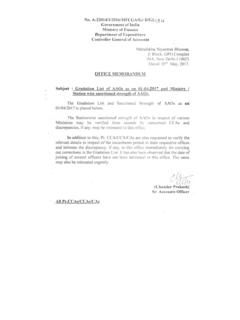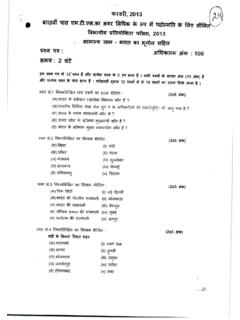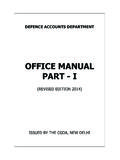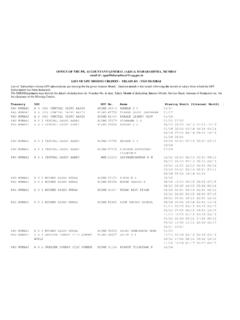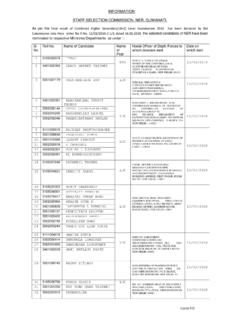Transcription of STUDY NOTE 1 - Controller General Of Accounts
1 MANAGEMENT ACCOUNTING STUDY Material Prepared By INSTITUTE OF COST AND WORKS ACCOUNTANTS OF INDIA for Junior Accounts Officer(Civil) Examination Conducted By Controller General OF Accounts STUDY MATERIAL PREPARED BY ICWAI FOR (CIVIL) EXAMINATION 1 BASICS OF COST ACCOUNTING Evolution of Cost Accounting, Cost Concepts and Cost Page . No Classification 1 Introduction 1 Evolution of Cost Accounting 2 Financial Accounting and Cost Accounting 3 Management Accounting 4 Financial, Cost and Management Accounting .5 Cost Concept and Cost Object 6 Cost Management 7 Cost Classification 10 Methods of Costing 12 Techniques of Costing 13 Specific Cost Systems 14 Cost Department and its relationship with other Departments 16 Installation of Costing System 17 Specimen Questions with Answers 18 Test Yourself 20 EVOLUTION OF COST ACCOUNTING, COST CONCEPTS AND COST CLASSIFICATION INTRODUCTION Traditionally, cost accounting is considered as the technique and process of ascertaining costs of a given thing.
2 In sixties, the definition of cost accounting was modified as the application of costing and cost accounting principles, methods and techniques to the science, art and practice of cost control and ascertainment of profitability of goods, or services . It includes the presentation of information derived therefrom for the purpose of managerial decision making. It clearly emphasises the importance of cost accountancy achieved during the period by using cost concepts in more and more areas and helping management to arrive at good STUDY MATERIAL PREPARED BY ICWAI FOR (CIVIL) EXAMINATION 2 Cost and Management Accounting business decisions. Today, the scope of cost accounting has enlarged to such an extent that it now refers to the collection and providing all sorts of information that assists the executives in fulfilling the organisational goals.
3 Modern cost accounting is being termed as management accounting, since managers being the primary user of accounting information are increasingly using the data provided by the Accounts , setting objectives and controlling the operations of the business. EVOLUTION OF COST ACCOUNTING Accounting is a very old profession. Financial accounting is in use with the dawn of civilisation. As soon as counting and arithmetic started, and the use of money replaced the barter system, the financial accounting emerged in some form or other. However, cost accounting is traceable to the earlier part of the seventeenth century. The earliest reference of cost accounting can be found in Robert Loder s farm Accounts 1610 20. However, the industrial revolution in the 18th century brought about extensive mechanisation of production system resulting in large scale production. Some sporadic efforts were made in and to install factory cost systems as far back as 1805.
4 But the concept of prime cost was used around 1875 by some industrialists. Between 1885 and 1901, a number of publications from London and New York explained the cost of manufacture, the distribution of establishment charges, the commercial organisation of the factories, factory Accounts their principles and practices, and finally a complete text book on Cost Accounting Theory and Practice was published by from New York in 1913. The cost accounting concepts advanced further with the beginning of the First World War. The cost plus concept was introduced during the war time in order to avoid delay in executing urgent supplies. The contracts were entered on the basis that the supplier would be reimbursed the cost plus a fixed percentage to cover administration and other overhead expenses and profit. Immediately, two things happened. One, a demand for qualified persons to calculate cost and two, deliberation of cost concepts for identifying the items or elements that enter the cost.
5 The profession of cost accountancy got a real boost-up. More and more people got interested in the profession. In 1919, the Institute of Cost and Works Accountants was established in , which is now known as the Chartered Institute of Management Accountants (CIMA) at London. Simultaneously, in the National Association of Cost Accountants, which is now known as the National Association of Accountants, was also established at New York. Under the leadership of these two institutes, the profession and the concepts of cost accounting developed significantly. Before the Second World War, the mechanism of standard cost accounting, budgetary control, flexible budgeting and direct costing became known in the and In India, prior to independence, there were a few cost Accountants, and they were qualified mainly from (now CIMA) London. During the Second World War, the need for developing the profession in the country was felt, and the leadership of forming an Indian Institute was taken by some members of Defence Services employed at Kolkata.
6 Costing profession was in an embryonic stage at that time. However, with the enactment of the Cost and Works Accountants of India Act, 1959, the Institute of Cost and Works Accountants of STUDY MATERIAL PREPARED BY ICWAI FOR (CIVIL) EXAMINATION 3 Basics of Cost Accounting India was established at Kolkata. The Institute has grown in stature, having Fellow, Associate and Student Members. The Institute controls its function through its Head Office at Kolkata and four Regional Offices at Mumbai, Kolkata, Delhi and Chennai. Each of the Regional Offices has several chapter Offices to look after the interest of the local members and the profession. The profession assumed further importance in 1968, when the Government of India introduced selective Cost Audit under Section 233-B of the Companies Act, 1956 and framed Cost Accounting Record Rules, 1968 for this purpose.
7 Although Cost Audit is not compulsory, but selective for a few nominated industries yet the profession was greatly benefited, and more persons are now interested to join the profession. Today, the extensive use of cost accounting techniques has led to new concept of information technology, operational control and performance measurement. The concepts of Activity Based Costing (ABC), strategic control systems, flexible production system etc. are key words for modern cost management. FINANCIAL ACCOUNTING AND COST ACCOUNTING In financial Accounts , the monetary transactions of the business are recorded, classified and analysed in an orderly manner, so as to prepare periodic results in the form of profit and loss account or income statement and balance sheet, indicating the financial position of the business at the end of that period.
8 The financial accounting is guided by various rules and regulations, some of which are mandatory. The system cannot normally deviate from the accepted accounting practices. The object of financial accounting is to provide information mainly to outsiders such as shareholders, investors, government authorities, financial institutions, etc. The analysis and interpretation of financial data contained in the income statement and the balance sheet enable persons interested in the business to make meaningful judgement about the profitability, liquidity and solvency of the enterprise. Besides, income-tax, central excise, banks and insurance companies rely on the data contained in the financial accounting, on the other hand, deals with the ascertainment of the cost of product or service. It is a tool of management that provides detailed records and reports on the costs and expenses associated with the operations, mainly for internal control and decision making.
9 Cost accounting basically relates to the utilisation of resources, such as material, labour, machines, etc. and provides information like products cost, process cost, service or utility cost, inventory value, as to enable management taking important decisions like fixing price, choosing products, preparing quotations, releasing or withholding inventory, etc. The objective of cost accounting is to provide information to internal managers for better planning and control of operations and taking timely decisions. In the early stages, cost accounting was considered as an extension of financial accounting. Cost records were maintained separately. Cost information and data were collected from financial books, since all monetary transactions are entered in the financial Accounts only. After developing product cost or service cost and valuation of inventory, the costing profit and loss account is prepared.
10 The profit and loss figures so derived by the two sets of books financial Accounts and cost Accounts , would have to be reconciled, since some of the income and expenditure recorded in STUDY MATERIAL PREPARED BY ICWAI FOR (CIVIL) EXAMINATION 4 Cost and Management Accounting financial books do not enter into product cost, while some of the expenses are included in cost Accounts on notional basis without having incurred actual expense. However, a system of integrated account has been developed subsequently, wherein cost and financial Accounts are integrated avoiding maintining two sets of books. The basic difference between financial and cost accounting may be summarised as follows: Financial Accounting Cost Accounting 1. Accounting of monetary transactions of 1. Accounting of product cost or service cost. the business. 2. Consists of recording, classification and 2. Consists of developing product or service cost analysis of financial transactions.

